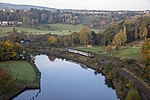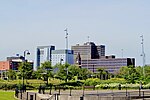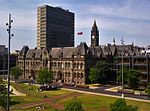Middlehaven

Middlehaven is the oldest part of Middlesbrough, North Yorkshire, England. It is directly south of the River Tees and it is to the north of the current centre, separated by the railway and the A66. The area has had waves of regeneration since post-war devastation. The area currently includes from (west to east) a manufacturing and industrial sector, Boho Zone developments (residential and commerce), the Old Town Hall, the Transporter Bridge, Middlesbrough College, docks and the Riverside Stadium. The term St Hilda's for the area relates to the former priory that was founded by Hilda of Whitby (the first mention of the town) and later also former church as named after the saint. The railway and the much later built A66 separating the area from the rest of the town created the term Over the Border for the area. The name Middlehaven is a back formation from Middlesbrough, combining "Middle" with "haven": the haven relates to Middlesbrough Dock.
Excerpt from the Wikipedia article Middlehaven (License: CC BY-SA 3.0, Authors, Images).Middlehaven
Geographical coordinates (GPS) Address Nearby Places Show on map
Geographical coordinates (GPS)
| Latitude | Longitude |
|---|---|
| N 54.5825 ° | E -1.2338 ° |
Address
TS2 1JP , Middlehaven
England, United Kingdom
Open on Google Maps










